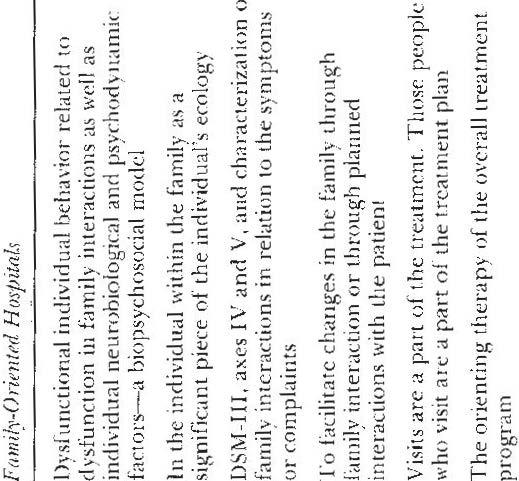
18 minute read
Assessment for HospitaliLation Alternatives to Hospitalization ... .... ......... ... .. .. ....... l
14 The Family, the Patient, and the Psychiatric Hospital
tion occurs in less than leisurely circumstances such as when there is an abrupt precipitati�g event or emergency. The professional may use phone contact with family members or may have to engage in decision-making processes "under the gun" without sufficient dala about the distressed person's pool of social resources. Police, psychiatric emergency teams, or community-empowered agencies may have to be used to contact disturbed persons in situ; occasionally, the psychialrist makes a home visit.
Advertisement
A danger in the assessment process is that the family may focus on the identified patient as the prnblem and may encourage the professional to do so . .Especially in critical circumstances, even the systems-oriented professional is not immune from seeking causes or finding fault in order lo understand how a difficult situation came LO be. Family members must be made to feel that they are not being blamed, but are participating together in a problem-solving task.
If a symptomatic individual is seen as having a functional disorder, the consultant is prepared to explor� the relevant contextual patterns in both diagnosis and intervention. Even i� the patient has a condition now thought to have a largely b1olog1cal substrate, such as a psychosis or affective disorder, it is just as vital for the consulLant to focus on the context of the illness rather than on the "illness" itself. The investigation with the family naturally includes personal and family histories. It is important, too, to examine the interpersonal aspects of the problems and to identifv the interactional patterns which may have a bearing on cu'rrent difficulties.
ASSESSMENT FOR HOSPITALIZATION
The clinician who has a family perspective about treatment will inevitably think about hospitalization in the context of a treatment plan for the entire family. Thus, concerns about the patient's condition will not alone determine the professional's decision. Wynne (1982) has detailed the data that
Family Assessment 15
family therapists need for treatment planning. These data include the presenting problem and its context, the family composition, the family's expectations and wishes, previous attempts to work on the problems and the results of such efforts, the family's resources, and the therapist's ohservaLions of family lransactions.
On the other hand, Fleck (1983) has emphasized the importance of family leadership, the boundaries between members, the levels and kirnls nr emotion, family affens, 1 he effectiveness of family communication and problem solving, and the developmental stages and goals of r.he family. These differing guides to evaluation suggest the range of data that arc available in family interviews.
Family members provide information more freely when they feel the therapist understands an<l appreciates lb�m and is reasonably empathic about their needs. The first rule of assessment, after bringing the family together, is to clearly accepl and label their actions in the current crisis as wellintentioned and caring for the idenlified patient. This is a significant part of the joining process which involves personal confirmation and validation, and which underlies most cl'fective therapy. Even when family members are infuriated, hostile, and clearly desirous of getting rid of the patient, it is possible to recognize that these are natural feelings under the circumstances, that symptomatic or ill individuals can be infuriating, and that the intensity of the response reflects involvement and concern for the patient.
A second rule in the assessment process is that r.he evaluator is in charge. Each system requires a leader: hierarchy is important. Thus, by assuming leadership in Lhis situation and by discovering the natural leadership operations within the family, the professional underscores this important system function. It is important that the therapist ha\·e a clear view about being in cha·rge. Prehospital cvalualions can often threaten t:O get out of hand under the pressures of criticism and unmodulaLcd affect, all of which expresses the urgency
16
The Family, the Patient, and the Psychiatric Hospital
of the situation. Some clinicians argue that it is important for these feelings to manifest themselves, but we feel that at this stage it is preferable to err on the side of eliciting competent behaviors-that is, all of those coping skills and strengths which are still available, even in this critical situation.
Let us look at the previous case example from a family perspective:
Case example: Larry and tthel's IH-year-old boy lost control and discharged a .22 rifle in his mother•.� presence. His mother called his fat her, a football coach. The father enlisted the aid of a friend who was a family-oriented psychiatrist. At the psychiatrist's office, the family provided the following information: I) The boy was furious after he had been grounded and his car keys taken away because of two minor car accidents in the preceding week, the last 011e only two days prior to the crisis; 2) The boy stated that he had shot. the .22 rifle at the ceiling. not at hi� mother; �) llis history was one of trying to bully his parents into doing for him ,,,hat he wanted; examples included their giving him an expensive car as soon as he was able to get a license, as well as other items they could barely afford; 4) Although bright, he was doing poorly in school.
The psychiau·ist identified a pattern in the family !hat went as follows: The mother would attempt. weakly, to set some limits and resist the boy's demands. The father· would give in to "keep rhe peace," apparenlly afraid that his son would become like those youngsters he coached. Although bright. the boy was doing poorly in school.
In the psychiatrist's office, confronted with the combined frustration or his parents, the boy was chastened by the consequences of his behavior and acknowledged that he found himself in a pickle. He admitted that the scene had gone too far. His mother did not believe that he wanted to kill hei. She herself appeared depressed, felt isolated and overwhelmed, and did not know how to handle her son. She expressed frustration at not being backed up by her husband. The father recog-11ized that perhaps he had teh too much of the burden of dealing with his son to his wife and that he had tended to get involved only when there was some sort of crisis.

Family Assessment 17
From this perspective. the therapist. observed sympathetically that the boy himself must feel overwhelmed with these kinds of family problems. He noted. further. that neither the boy nor his parents seemed to know how to handle rhe situation. He then added that the youngster had successfully brought the problems to the attention of the outside world, perhaps in the hope that the family could, with some help, work it out. \,Vith this definition of the situation, the family could participate without fear or anger in the decision about wher.her ro work on the problem on an outpatient basis or to press for hospitalization. They now dearly saw the family as participating in the pniblem. The family was the "patient."
At this point, if the family were feeling r·casonably comfortable that all of the members would he helped in the ongoing treatment, they might agree to an i11tensive outpatient l,rocrram with the initial groals ol' working out family rules and � ... ' . limits so that nobody would be betrayed or cheated, and eventually the parents could be on the same side.
When the evaluatm sympathetically gathers information while concomitantly diffusing the patient's or the family's efforts to attribute blame, the process of evaluation is further facilitated. The more someone hears, "I can appreciate your upset in such circumstances," the more it is likely that rn _ a _feelings will emerge. When the evaluator goes on to L _ ure d1ftuse a spedfic or unifocal search for lhe cause of the problem to include the conOuence of many forces involved, this too may help loosen the ties of the participants to a blame-guilt cycle.
The "multilateral" position (Boszormenyi-Nagy & Spark, l 973)-i.e. considering each person's pe::r·spective and contribution--of the evaluating professional not only promotes the best chance of engaging the members of family, but also provides an opportunity for evaluation of their flexibility and responsiveness. When the fa1�1ily'� desire to have the , symptomatic member "put away" 1s retramed as everyones need for a different kind of space for growth at this time, cautious and curious glances may be exchanged, signaling _ fa1:1ily ability to shift perspectives. On the other hand, the farmly mcm-
18
The Family, the Patient, and the Psychiatric Hospital
bers and patient may remain affectively and cognitively immobile, unable to consider any alternative possibilities at the moment. In either case, the evaluator has gained import.ant information about the family and has set a tone for possible hospitalization that includes the family ,t:s a constructive force in the ongoing treatment. For example, if the youngster in the aforementioned case is still angry and demanding about the sanctions levied by his parents, while the mother remains overwhelmed, reproachful of her husband, and says she can't take it any more, and the father persists in defensive helplessness, hospitalization may be chosen as a context to begin the work with the family. Hospitalization would pn)vide a muling-off period, a sense of the critical nature of these events, and a11 opponunity for remoralization.
Al TERNA TIVES TO HOSP IT ALIZA TION

When the clinician indudes the family in the prehospitahzation assessment, other factors in the decision on whether or uot to hospitalize will be: l) the family's readiness and skill to care for the patient in a less restrictive setting; and 2) the family's need for relief from the stress of caring for the patienl. There are several alternatives to hospitalization in acute family crises that can be consi<lcred if the clinician views individual problems in the context of 011going family living.
We will discuss two of the most prominent alternatives -treatment in the home an<l partial hospitalization. In home treatmen1, the disturbed person remains in the home and the family routines are not disrupted by the removal or a memher. Such a management approach may require regular, frequent visits to a treatment facility, home visits by a treatment team, or employment of persons from outside the family for substantial portions of each day. Home treatment services have been successful in a variety
Family Assessment 19
of settings around the country (Friedman, Becker & Weiner, 1964; Pasamanick et al., 1967; Langsley et al., 1968, [ 969, 1971; Smith et al., I 976; Fenton el al., I 979). In these varied clinical settings, there is a general consensus that at least 60 percent of the patients could be treated in the home and thus avoid hospitalization. Friedman et al. ( I 964) found in their home treatment service that when the patients were evaluated for admission first in the emergency room, it was almost. impossible to maintain the patient outside the hospital. The results were much supe:1'�or i1� preventing . hospitaliLation if the evaluation began �•11t1ally m th� home. 1 heir overall conclusion was that early •�tervent1on •� the key _ lo successfully maintaining severely disturbed patients outside of the hospital. However, other researchers (Langsley et al., 1969) selected their patients randomly fro1�1 those . who were presented to the emergency •:oorn and J _ ud�ed 1�1 n�ed o� admiss�on by the emergency room psycl11atnst. Workmg with an active home visiting team C ) } t 1ey were able to avoid hospitalization and to decrease the amount of time the patient was disabled and unable to work. 1:"he r�sults from treating suicidal and acutely psychotic patients m the home suggest the following:
l. ·1 _ ·he treatment fa�ility must have a team of professionals who are onent.ed toward family imervention and who are dedicated to this approa�b. 2.The results were at least as good as and sometimes better than traditional psychiatric hospitalization in short-term follow-up and about the same in longerterm follow-up. 3.· I"he costs of managing the crisis effectively out of the hospital are much less than the costs invoi'ved in hospitalization.
It is also quite possible to care for severely disturbed individuals in a partial hospital setting either by utilizing· day
20
The Family, the Patient, ond the Psychiatric Hospital
hospitalization, with the family actively inrnlved in t�e management of the patienL <luring the night, or �y having t __
he patienl in the hospital at night with the family 1m'.olve� w1 _ th rhe patient during the day. A careful assessmc _ nt _

of the tam _
tly patterns, sources of strength, and charactenstt�s of . the mdi vidual patient determines the choice ot the urne mterval for which institutional assistance is more important. The duration of day hospital treatment tends to be longer than that of iupatient settings, but the day treatment group shows a reduced frequency of hospital returns (Wilder et _
al., 1966). There are a number of demonstrations w!th the �1 _
milar conclusions that. partial hospitalization is a viable, effective and more economical approach to the treatment ofsev�re emotional disorders. However, these exist in few areas of the country. The inpatient hospital is still tl�e most prevalent and available facility for the treatment ot severe emotional crises. A significant portion of the problem is related to the financial policies of the health care system that reunburses more generously for hospitalization than for 1 __
he less expensive community-based alternative. It also ,s _ poss1?le tor some professionals to make more mon�y wor�mg with patients in the hospital than when engaged m the chffic.ult struggle to cn:ate and maintain o _
utparient care and :5upport options. Third-party payers often arc g-eared to reimburse for full hospitalization, but do not understan? or have _ the facilities to handle either partial care or mrens1ve outpauenr. care to the extent required to support those programs so that they can be successful.
All the community-based programs, whether . parual hospitalization or home treatment, r�quire � great invesll _
nent of time and energy on the part of a dechcated professional and paraprofessional staff. Few su�h programs _
have been maintained and verv little attention 1s currently given to developing them des1;ite their effective�css. �ack ?f finan�ial support has been blamed for their d1scont111�auo�. Prof�ssional burnout occurs also. And because there 1s so lmlc sooal
Family Assessment 21
and financial support for t.hese programs. often they arc not maintained after pilot funding has been spent. Nowadays, as our_ awareness of family relationship resources increases, the characteristics of the family not only are a m��jor fac1 or in the decision to hospitali£c, but also determine the ultimate effcctivc11ess of the hospitalization as a significant inlervcntion in the pa1iern's difficulties (Withersty, l 977; Gould & Glick, 1977). The important relationship between the family awl 1.hc hospital in the implementation of a satisfactory program has resulted in the felicitous term ''institutional alliance" (Stewal't, l 98'.2), referring to the mutual understanding between the family and the hospital staff. l11 some hospitals, the institutional alliance is implemented by developing a contract which serves as a written agreement between hospital staff and the family about the contributions of both sides to the treatment program an<l care needs of the patient (Combrinck-Craham, el al.. l !)82). This contract is initiated at the time of' admissio11 evaluation, then elaborated later ·when both the hospital staff and the family become increasingly familiar with each other. On the other hand, Stewart (1982) describes fom stages in the building of institutional alliances, beginning with I he crisis of the patient which brings the family into contact with the hospital, going on to the se/Jaralion which will occu1· when the patient is finally admitted and other family members go home, continuing with the family's rl'i11110/i,emr11t in in-hospital programs, and ending with evaluation, which represents the stage at which the family offers itself for more intensive involvement in the uuuerstanding of the problem and its treatment. 11 is stressed that different families may go through these stages with different timing. There are at least two kinds of families with whom building the institutional alliance will be particularly difficult-disengaged families, in which individuals feel little connection to each other and may be little affected by the crisis, and families who are characteristically hostile and suspicious of unfamiliar "outsiders'' (Reiss ct al., 1980). Yet there


24

The Family, the Patient, and the Psychiatric Hospital

i3 .....:
The Hospitalization and Family Intervention 25
interfering with treatment. Social workers, rather than psychiatrists, were usually <ldegated the task of dealing with these l'amily-engeudered problems. Prior to the availability of effecrive somatic treatments, hospital stays were much longer and already-fragile family tics were often broken. Even now with shorter stays, public hospitals are often geographically distant from family members, making access difficult. Furthermore, since the hospital 1s associated with much fear and stigma, many families are only too happy to stay away. In the I 970s, hospitals -began to struggle with the newly introduced model of family therapy which suggested that illness was embedded in a family context and often directly responsive to other family members. New social workers were hired to "do family therapy,'' but the rest of the treatment package ,vas unchanged. This ma<le the social worker's job difficult and conveyed a confusing message to the family. This model of hospitalization frequently has the unintended effect of promoting further hospitalization down the liue. Recent evidence (Mattes et al., 1977a, l 977b) suggests that when a mentally ill individual ts hospitalized for long periods of time (i.e., separated from his or her family and integrated into the hospital environment), a less than optimal copmg pattern begins which sees hospitalization as the solution to the family problem. This pattern may be repeated each time the individual manifests the same disturbances. A family-oriented hospitalization, on the other hand, views the problem in systemic terms. All persons in the family system are considered (in varying degrees) as interacting with the problem, and hospitalization is geared to supporting family functions (Glick & Kessler, 1980). BACKGROUND
In some cultures, families are considered a vital part of the psychiatric hospitalization of any of their members. Because
26 The Family, the Patient, and the Psychiatric Hospital
of a scarcity of trained professionals and other resources such as food, families are essential to care for the needs of the identified patient. In fact, families often stay with the patient in or near the hospital. The assumption in these other cultures reflects diff erent patterns of family care and affirms that the patient is an integral part of the family network. It is unthinkable that the patient would return anvwhere but to the family (Bell & Bell, 1970). Based on this concept, a number of innovative hospital programs in our culture have included more than one family member in the hospitalization. These programs fall into three categories: l) those which attempt to identify the entire family as the patient (Abroms et al., 1971; Bowen, 1966; Combrinck-Graham ct al., 1982); 2) those which attempt to use family resources in treatment of a disturbed family member and to change roles and functions in the family during the intensive treatment phase of the hospitalization (Bowen, 1966; Combrinck-Graham et al., 1982; Bhatti et al., 1980; Grunebaum et al., 1982; Grunebaum et al., 1963; Lynch et al., 1975; Main, 1958; Nakhla et al., 1969); 3) those which use the hospital as a laboratory for change in familial relationships (Abroms et al., 1971; Bowen, 1966; CombrinckGraham et al., 1982; Bhatti ct al., 1980; Nakhla et al., 1969; Whitaker & Olsen, 1971). A pilot experimental effort to include more than one family member in the hospital was reported from Wisconsin (Abroms et al., 1971; Whitaker & Olsen, 1971). Here, admitting more than one family member became the rule. Since it was an adult ward with an already established milieu, family members who had not considered themselves to be patients were quickly socialized as patients by the others in the community. Staff members became aware of how they themselves were incorporated into the family triangles, and maneuvering in these patterns became a conscious part of the treatment experience in the hospital. One program has continued to treat a small number of families (in two apartment inpatient

The Hospitalization and Family Intervention 27
facilities) (Combrinck-Graham et al., 1982). Another effort involved the hospitalization of infants along with their psychotic mot.hers as a means of observing and of having the opportunity to foster a better mother-child relationship (Grunebaum et al., 1963; Grunebaum et al., 1982; Main, 1958). These experiments involved considerable effort, however, and, in most cases, when certain committed staff left the ward, this kind of family intervention was discontinued. A MODEL FOR INPATIENT FAMILY INTERVENTION
Hospitalization should be viewed in most cases as an event in the history of the family, an event that can be devastating or valuable depending upon the skills and orientation of the therapeutic team. When hospitalization is viewed in this way, it becomes central to understand the role of the patient in the family system and to support the family as well as the patient. The hospital becomes an important therapeutic adjunct not only for severely dysfunctional individuals and their families, but also for families who are stuck in modes of relating that appear to interfer� with the development and movement of individual members. For these families, hospitalization aims to disrupt the family set; this disruption can be used to help the family system to change in more functional ways. Family-oriented programs can be implemented within existing hospital resources, though there is a general trend toward adapting and revising hospital environments to include family members in patient care. (This trend is also noted in other specialties, such as "rooming in" in obstetric and pediatric units.) Effective programs involve the staff, from admission clerks on up, in building an alliance with the family. Stewart describes this as "the engagement of the family with the institution in a relationship that achieves mutual understanding and support and establishes clarity, acceptance, and commitment to mutually agreed upon goals for








